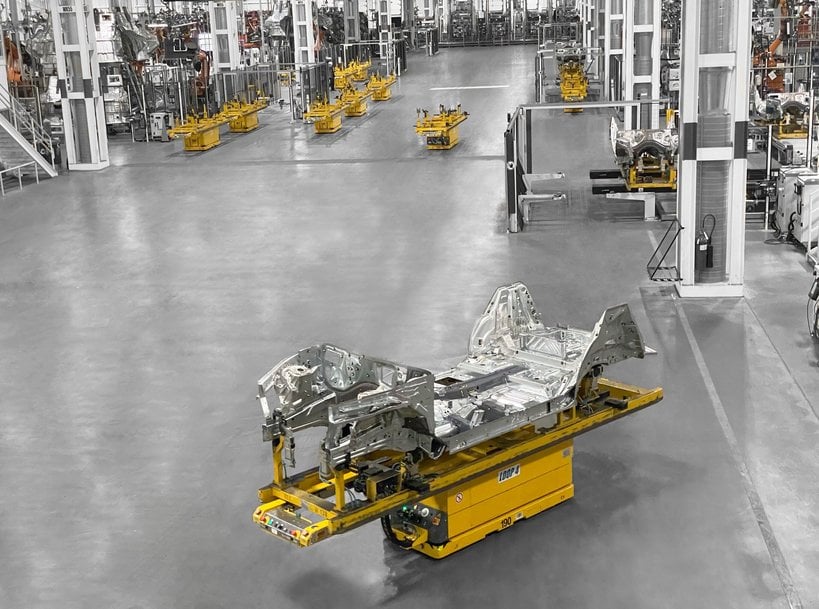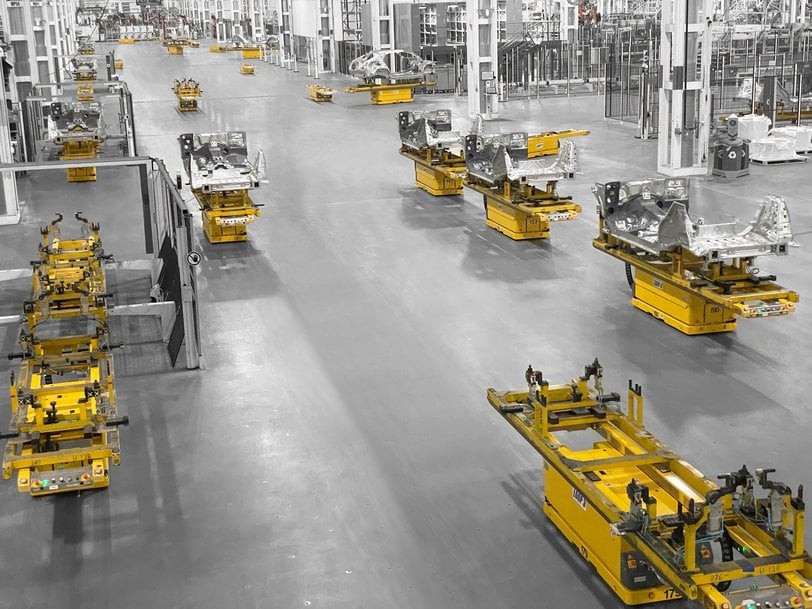www.magazine-industry-usa.com
25
'21
Written on Modified on
In the body shop of the international automobile premium manufacturer, an automated guided vehicle system makes fully automated production safer and more efficient
As general contractor, KUKA was responsible for the AGV system integration in the entire body shop: from the development of the safety concept, through planning, engineering, simulation and project management. A milestone was set in the AGV supported production of vehicle bodies.

Fully automated body-in-white production flexibly interlinked
The basic structure of the three vehicle models is created in the body shop, the so-called body-in-white: Here, the underbody is joined and welded to the side walls and the roof, followed by add-on parts such as the hood, the tailgate and doors. The body-in-white is mainly carried out fully automatically using KUKA KR QUANTEC, KUKA KR FORTEC and other KUKA robot models.
Engineering know-how for efficient intralogistics solutions
To ensure that the system linkage within this production section ran smoothly, Mercedes-Benz commissioned the automation specialist KUKA. "As general contractor, we have the necessary engineering know-how to plan all process steps and workflows and successfully implement the complex project handling with all trades", explains Michael Jürgens, Head of AGV Solutions at KUKA. After the KUKA team had developed the safety concept for the automated guided vehicle system and planned and simulated the flexible system linkage using around 100 automated guided vehicles (AGVs), KUKA coordinated the successful implementation of the automated guided vehicle system.
Personal safety through forklift-free production
In order to increase the safety of the employees, the transport of the body parts between the body shop lines is forklift-free. To ensure that components and car bodies arrive at the process stations just in time, KUKA has developed an automated guided vehicle system. This efficient intralogistics solution ensures that around 100 AGVs coordinate the delivery of the required components of the respective vehicle model at the right time to the right production station, where they are assembled without intermediate buffers. Numerous work steps take place here simultaneously in two process modules. At the same time, the AGVs must meet the high safety standards for interaction with the people in the plant. This means that the AGVs use optical sensors, among other things, to detect when there are people or other obstacles in the driving area. "In this case, the AGVs stop in an intrinsically safe manner and also give an acoustic and optical warning", describes Felix Tschorn, Project Manager AGV Solutions at KUKA. "Only when the road is clear again do the vehicles continue the transport."

Nearly 100 AGVs in a fleet are involved in transporting body components and complete car bodies
Free navigation in harsh production environments
"The particular challenge of the project lay in the complexity and scope of the plant linkage," says Felix Tschorn. "The intralogistics solution was to control the AGVs centrally and at the same time enable flexible route guidance by means of free navigation." The AGVs are navigated via a magnetic grid network. For this purpose, magnetic points are embedded in the floor of the production area at a certain distance. Sensors on the automated guided vehicles use this orientation aid to determine their exact position and report it to the central guidance system. The central guidance system takes over the traffic simulation and vehicle control and ensures that all AGVs are coordinated to deliver the components to the right place at the right time along the most optimal route, on 11 intersecting loops.
Intuitive and central guidance concept
The master control of the automated guided vehicle system is directly connected to the Mercedes-Benz production control system. In this way the AGVs automatically adapt to the higher-level production planning without the need to intervene in the guidance system of the AGV. In the event of a break in production - for example on public holidays or long weekends - the AGVs automatically go into stand-by mode, which can last up to 92 hours. If production restarts within this period, the vehicles automatically resume their activities. The AGV guidance system also ensures fully automated charging management. The AGVs drive autonomously to the charging stations and are thus ready for operation 24/7. A graphical user interface (GUI) allows new routes to be planned and simulated easily and intuitively. The system linkage, which takes place at the same level as the production system, allows very quick and easy adaptation to changes in the production infrastructure, for example to integrate new model series. Another advantage of free, inductive magnetic grid navigation: In the harsh environment of the body shop, optical sensors can be contaminated by welding dust, for example. Navigation using magnetic grids is insensitive and robust, which makes it particularly reliable.
Milestone in intelligent intralogistics
"The intelligently networked automated guided vehicle system ensures smooth plant linkage and more safety for the workers in the body-in-white production," summarizes Michael Jürgens. The automated guided vehicle system in the body-in-white of the production plant in Tuscaloosa is a forward-looking pilot project. "We are proud of the successful implementation of the project; it is considered by all those involved to be a milestone in intelligent intralogistics. And we are even more pleased about the continued cooperation and the trust in our know-how," concluded Felix Tschorn.
www.kuka.com

